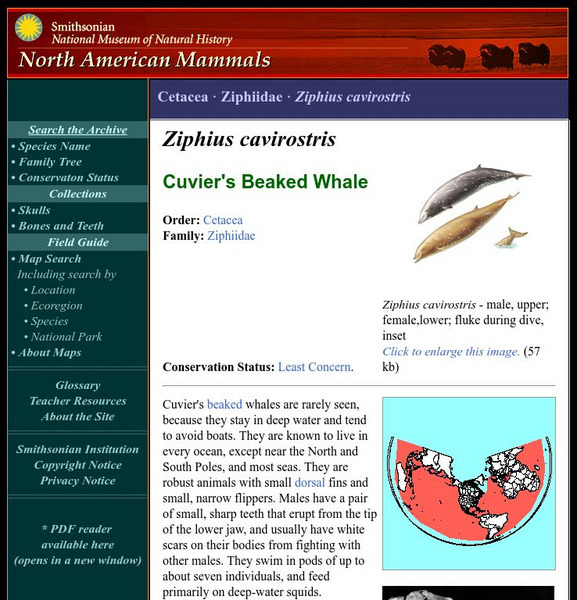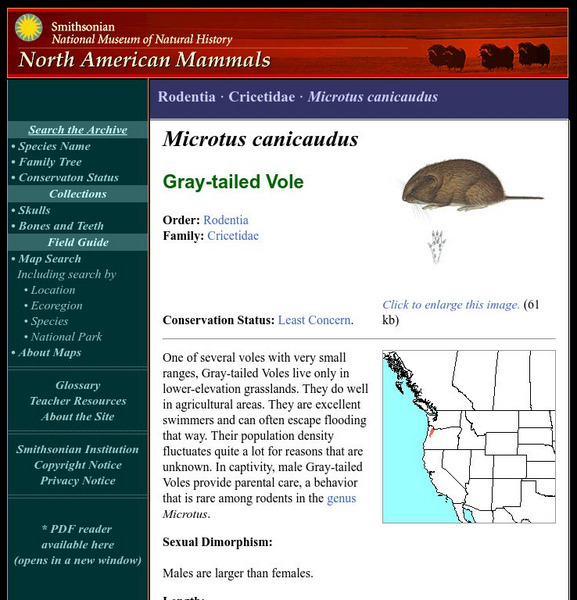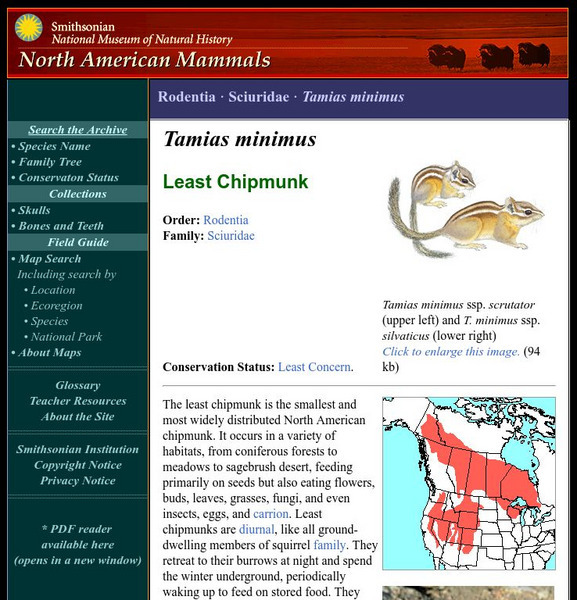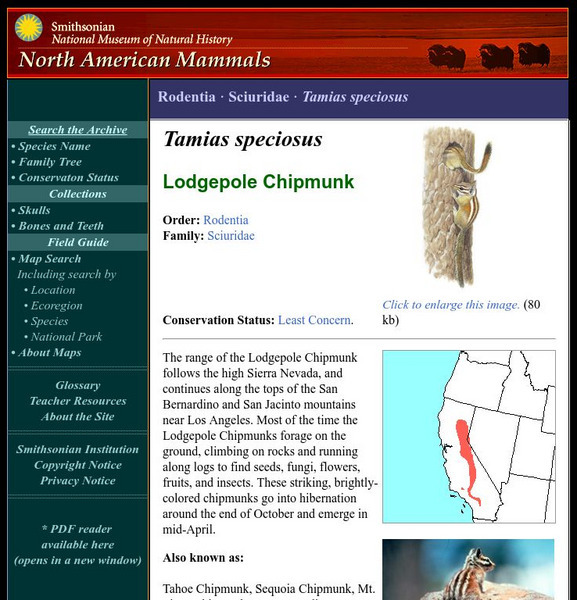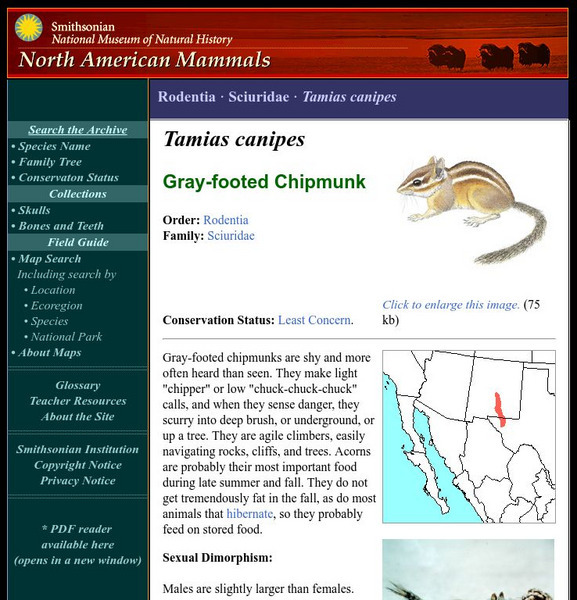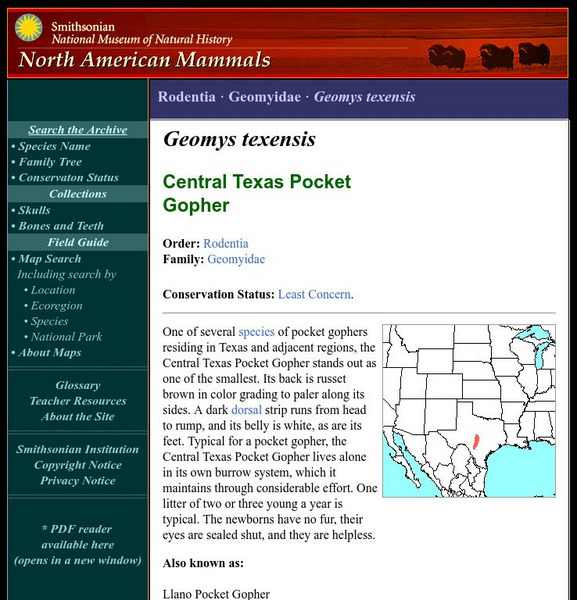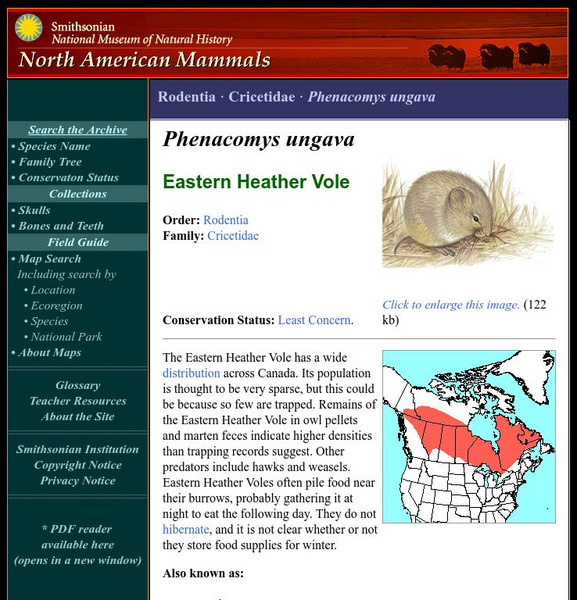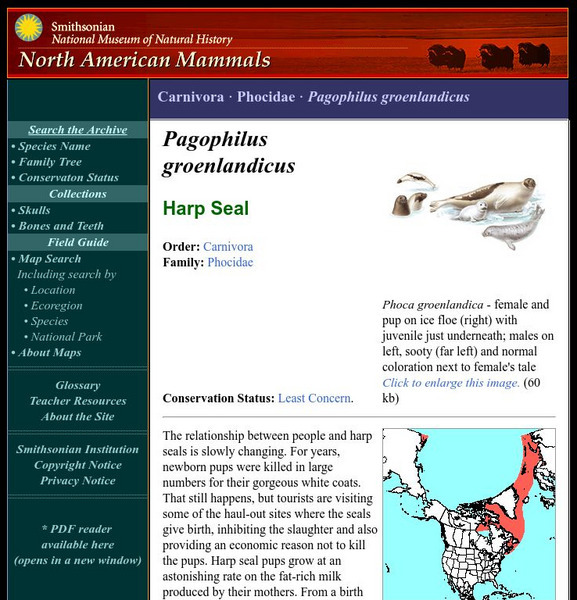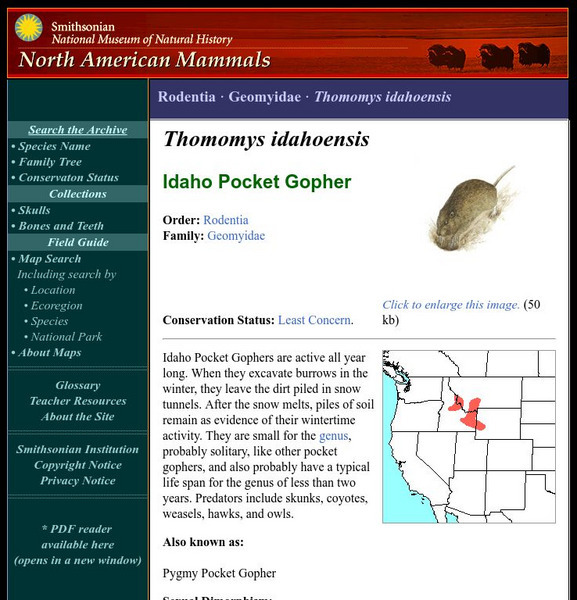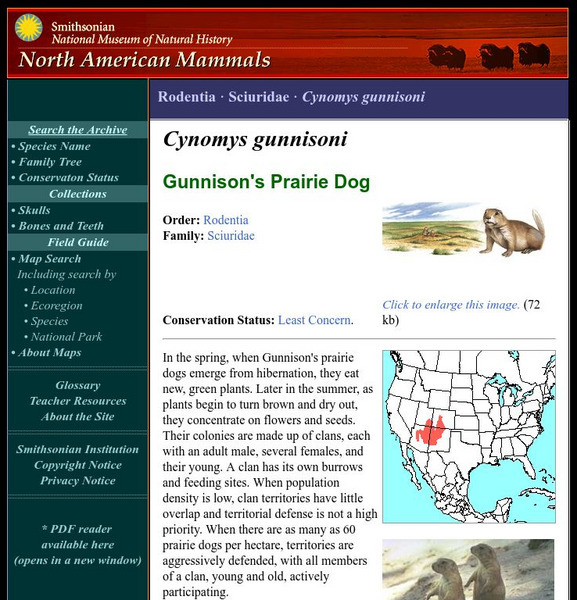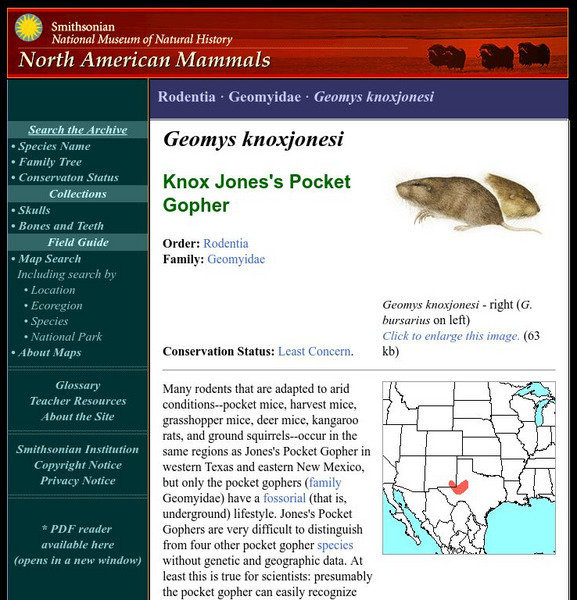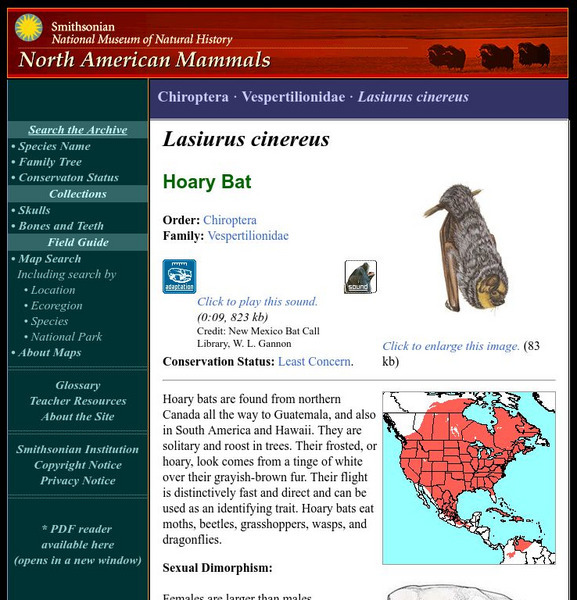Smithsonian Institution
National Museum of Natural History: American Mammals: Eastern Spotted Skunk
Spotted skunks are smaller than Striped skunks and more weasel-like in appearance. Like all skunks, they have anal scent glands and can emit a foul-smelling spray to protect themselves. Learn more about the Spilogale putorius, more...
Smithsonian Institution
National Museum of Natural History: American Mammals: Cuvier's Beaked Whale
Cuvier's beaked whales are rarely seen because they stay in deep water and tend to avoid boats. They are known to live in every ocean, except near the North and South Poles, and most seas. Learn more about the Ziphius cavirostris, more...
Smithsonian Institution
National Museum of Natural History: American Mammals: Gray Whale
Gray whales are bottom feeders. They roll to one side and lower the lip to scour and siphon the bottom for tiny crustaceans, especially amphipods which are known as "sand fleas." Learn more about the Eschrichtius robustus, more commonly...
Smithsonian Institution
National Museum of Natural History: American Mammals: Humpback Whale
Humpback whales are among the best-studied cetaceans, yet they are still among the most mysterious. Among the mysteries are the reasons for their songs and the complex social behaviors that accompany them. Learn more about the Megaptera...
Smithsonian Institution
National Museum of Natural History: American Mammals: Gray Tailed Vole
One of several voles with very small ranges, Gray-tailed Voles live only in lower-elevation grasslands. They do well in agricultural areas. Learn more about the Microtus canicaudus, more commonly known as a Gray-tailed Vole, in this...
Smithsonian Institution
National Museum of Natural History: American Mammals: Insular Vole
There have been only scattered observations of the Insular Vole since 1885 because the two islands in the Bering Sea off the coast of Alaska where it lives are rather inaccessible. The Voles live in burrows dug in moist lowland areas, at...
Smithsonian Institution
National Museum of Natural History: American Mammals: Ermine
Ermine are highly adaptable predators, easily invading small burrows to feed on voles, mice, and young rabbits. They also eat earthworms, frogs, and squirrels, climbing trees and swimming if necessary. Learn more about the Mustela...
Smithsonian Institution
National Museum of Natural History: American Mammals: Least Chipmunk
The least chipmunk is the smallest and most widely distributed North American chipmunk. It occurs in a variety of habitats, from coniferous forests to meadows to sagebrush desert, feeding primarily on seeds but also eating flowers, buds,...
Smithsonian Institution
National Museum of Natural History: American Mammals: Lodgepole Chipmunk
The range of the Lodgepole Chipmunk follows the high Sierra Nevada, and continues along the tops of the San Bernardino and San Jacinto mountains near Los Angeles. Most of the time the Lodgepole Chipmunks forage on the ground, climbing on...
Smithsonian Institution
National Museum of Natural History: American Mammals: Eastern Chipmunk
Eastern chipmunks are found in forests, but also in suburban gardens and city parks, as long as there are rocks, stumps, or fallen logs to provide perching sites and cover for burrow entrances. They dig complex burrows with many...
Smithsonian Institution
National Museum of Natural History: American Mammals: Long Eared Chipmunk
Long-eared chipmunks are striking, with sharp, bright markings and the longest ears of any chipmunk. They live at middle elevations (970-2,290 m) in the Sierra Nevada Mountains. Learn more about the Tamias quadrimaculatus, more commonly...
Smithsonian Institution
National Museum of Natural History: American Mammals: Gray Footed Chipmunk
Gray-footed chipmunks are shy and more often heard than seen. They make light "chipper" or low "chuck-chuck-chuck" calls, and when they sense danger, they scurry into deep brush, underground, or up a tree. Learn more about the Tamias...
Smithsonian Institution
National Museum of Natural History: American Mammals: Gray Collared Chipmunk
Gray-collared chipmunks are found only in coniferous forests, at elevations of 1,950-3,440 m. They eat all kinds of vegetation and collect and store acorns underground or in hollow logs. Learn more about the Tamias cinereicollis, more...
Smithsonian Institution
National Museum of Natural History: American Mammals: Desert Pocket Gopher
The Desert Pocket Gopher is built for digging, with strong front legs and massive claws. Small eyes and ears are adaptations for traveling through tunnels. Learn more about the Geomys arenarius, more commonly known as a Desert Pocket...
Smithsonian Institution
National Museum of Natural History: American Mammals: Llano Pocket Gopher
One of several species of pocket gophers residing in Texas and adjacent regions, the Llano Pocket Gopher stands out as one of the smallest. Its back is russet brown in color grading to paler along its sides. Learn more about the Geomys...
Smithsonian Institution
National Museum of Natural History: American Mammals: Creeping Vole
Creeping Voles are found in moist coniferous forests at all stages of forest succession, from old growth to recent clear-cuts. In fact, population density is probably higher in recently cut areas where more sunlight reaches the ground...
Smithsonian Institution
National Museum of Natural History: American Mammals: Eastern Small Footed Myotis
The eastern small-footed myotis is one of the smallest North American bats. It has a limited range, occurring only in eastern deciduous and coniferous forests. Learn more about the Myotis leibii, more commonly known as an Eastern...
Smithsonian Institution
National Museum of Natural History: American Mammals: Eastern Heather Vole
The Eastern Heather Vole has a wide distribution across Canada. Its population is thought to be very sparse, but this could be because so few are trapped. Learn more about the Phenacomys ungava, more commonly known as an Eastern Heather...
Smithsonian Institution
National Museum of Natural History: American Mammals: Harp Seal
The relationship between people and harp seals is slowly changing. For years, newborn pups were killed in large numbers for their gorgeous white coats. Learn more about the Phoca groenlandica, more commonly known as a Harp Seal, in this...
Smithsonian Institution
National Museum of Natural History: American Mammals: Idaho Pocket Gopher
Idaho Pocket Gophers are active all year long. When they excavate burrows in the winter, they leave the dirt piled in snow tunnels. Learn more about the Thomomys idahoensis, more commonly known as an Idaho Pocket Gopher, in this...
Smithsonian Institution
National Museum of Natural History: American Mammals: Gunnison's Prairie Dog
In the spring, when Gunnison's prairie dogs emerge from hibernation, they eat new, green plants. Later in the summer, as plants begin to turn brown and dry out, they concentrate on flowers and seeds. Learn more about the Cynomys...
Smithsonian Institution
National Museum of Natural History: American Mammals: Hooded Seal
Male hooded seals have a fleshy sac above the nostrils that they can inflate. It grows as the animal gets older, and looks a lot like a hood over the nose, thus the name "hooded seal. Learn more about the Cystophora cristata, more...
Smithsonian Institution
National Museum of Natural History: American Mammals: Jones's Pocket Gopher
Many rodents that are adapted to arid conditions--pocket mice, harvest mice, grasshopper mice, deer mice, kangaroo rats, and ground squirrels--occur in the same regions as Jones's Pocket Gopher in western Texas and eastern New Mexico,...
Smithsonian Institution
National Museum of Natural History: American Mammals: Hoary Bat
Hoary bats are found from northern Canada all the way to Guatemala, and also in South America and Hawaii. They are solitary and roost in trees. Learn more about the Lasiurus cinereus, more commonly known as a Hoary Bat, in this...

